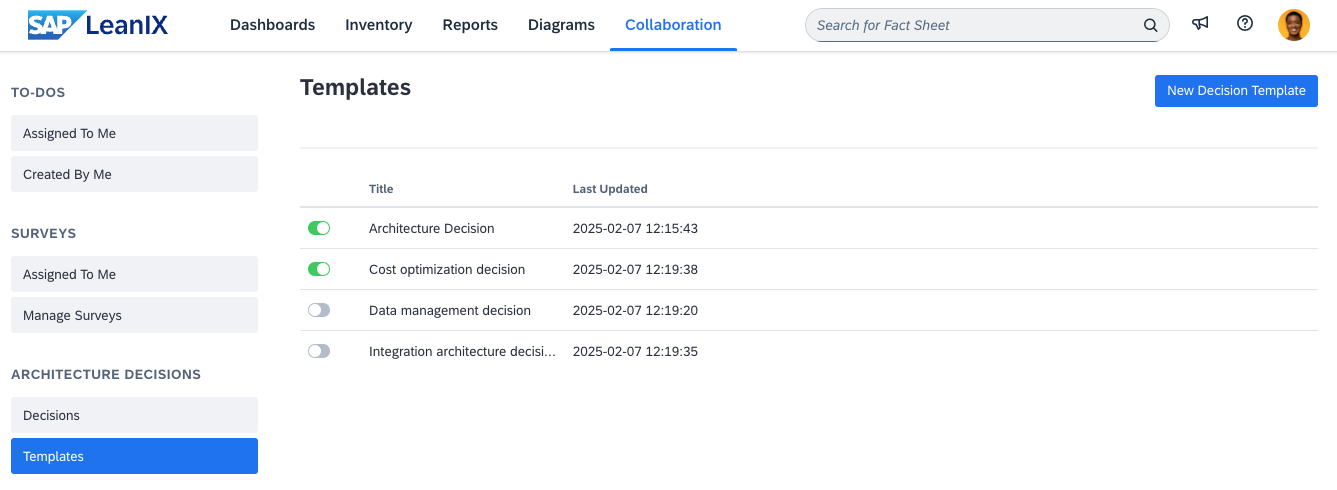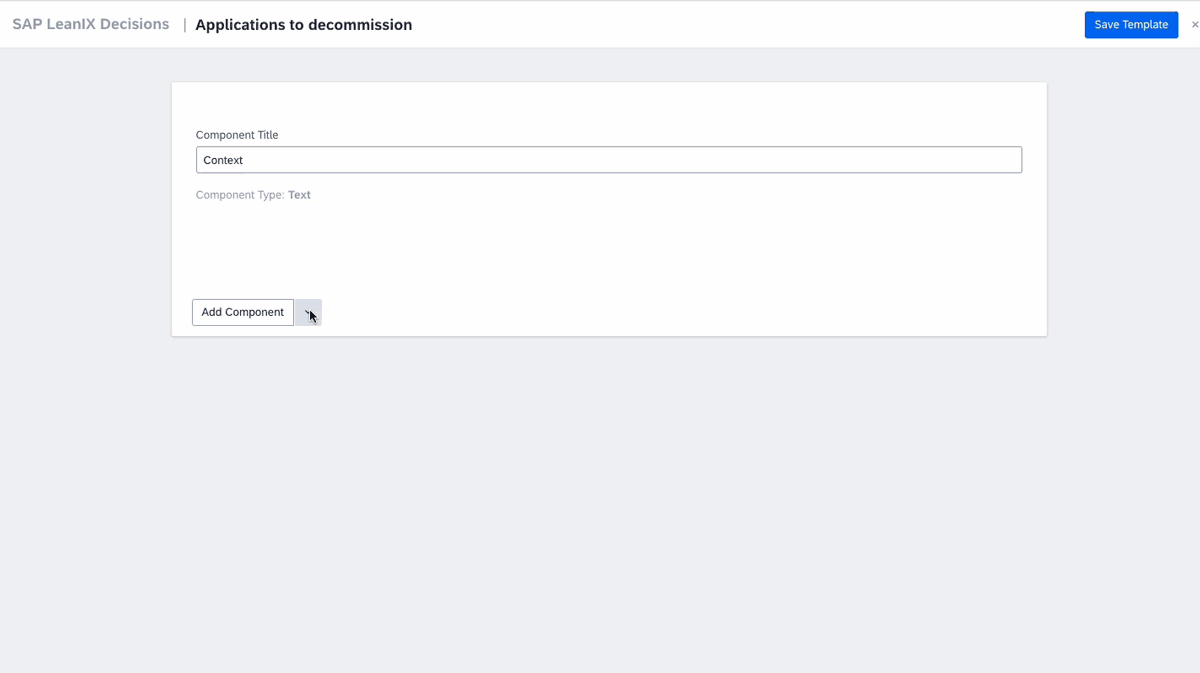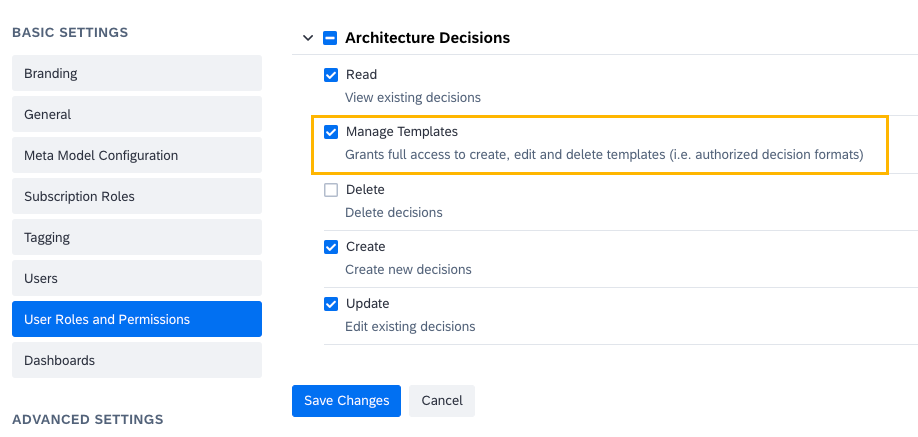Architecture Decision Templates
Templates provide a predefined structure for architecture decisions, enhancing consistency and streamlining the creation process. Users with appropriate permissions can create custom templates that align with their organization’s decision types.
Overview
Templates provide a predefined structure for architecture decisions, allowing users to focus on entering relevant data without the need to create the decision structure from scratch. Templates standardize the decision-making process, ensuring that all necessary aspects are considered and facilitating a smoother review process for decision-makers. By providing a clear agenda, templates enhance the efficiency of meetings related to strategic initiatives.
By default, only admins can create and manage templates. However, they can grant full permissions to non-admin roles. If you have the appropriate permissions, click Collaboration on the navigation bar, then select Templates under Architecture Decisions on the left-side panel.

Architecture Decision Templates
Best Practices
- To get started with templates, you can use the default template available on the Templates page.
- If you already have existing templates, recreate them in SAP LeanIX to maintain consistency. If you don’t have existing templates, you can refer to relevant third-party resources for inspiration.
- Consider creating templates tailored to each committee in your organization to cover the most common decision scenarios effectively. Alternatively, you can create a single, comprehensive decision template to streamline reporting and navigation, making future decision-making processes more efficient.
Template Components
The table below lists available template components and explains when to use each.
| Component | Usage |
|---|---|
| Text | This component provides an input field for text in Markdown format. It's the base component for documenting key decision details, such as the background, options, decision, and comments. |
| Fact sheet | This component represents an architectural element associated with a decision. Listing affected fact sheets helps track the decision's impact across various areas of the IT landscape. |
| User | This component identifies workspace users involved in a decision. Use it to mention decision owners, approvers, or meeting participants. It ensures accountability and transparency by clearly identifying individuals in the decision-making process. - You can only mention active workspace users. - Users cannot subscribe to decisions. - Users don’t receive notifications when mentioned in a decision. |
| Date picker | This component allows selecting specific dates crucial for tracking and managing various timelines associated with a decision. Use it to set deadlines, validity periods, review schedules, and approval dates to ensure timely follow-ups and adherence to expected timelines. |
Creating a Template
By default, only admins can create templates for architecture decisions. However, they can grant full permissions to non-admin roles. For details, see Permissions.
To create an architecture decision template, follow these steps:
- On the navigation bar, click Collaboration.
- On the left-side panel, under Architecture Decisions, select Templates.
- In the upper-right corner, click New Decision Template.
- In the upper-left corner of the template page, enter a unique name for the template.
- Define the template structure by adding components. To do this, click the arrow next to Add Component, then select the component type. You can delete individual components or change their order when editing a template. To learn more about available components, see Template Components.
- Click Save Template.

Creating an Architecture Decision Template
The template is created as inactive. To activate the template, enable the corresponding toggle on the templates page. Users can create architecture decisions based on active templates. To learn how to do it, see Creating an Architecture Decision.

Activating an Architecture Decision Template
Managing Templates
Admins and non-admin users with appropriate permissions can manage architecture decision templates on the Templates page. Here, you can:
- Edit templates: Editing a template affects all architecture decisions based on it. Deleting a component within a template permanently removes all content stored in that component across all decisions based on the template. Always proceed with caution to avoid unintentional data loss.
- Activate or deactivate templates: You can activate or deactivate a template by switching the toggle next to the template name. Deactivating a template doesn’t delete architecture decisions based on it.
- Duplicate templates: You can create new templates by duplicating existing ones, which saves time when you need templates with a similar structure. To duplicate a template, hover over it, then click the duplicate icon that appears on the right.
- Delete templates: Deleting a template deletes all architecture decisions based on it. Always proceed with caution to avoid unintentional data loss.
Caution
When deleting templates or components within a template, always proceed with caution to avoid unintentional data loss. This action affects all architecture decisions based on those templates.
Permissions
By default, only admin users can create and manage templates for architecture decisions. However, they can grant full permissions to non-admin roles, enabling users to create, edit, and delete templates. To do this, follow these steps:
- Go to the User Roles and Permissions section of the admin area.
- Select a non-admin user role, then navigate to the Permissions tab.
- In the Architecture Decisions section, select the Manage Templates checkbox, then save the changes.

Adjusting Permissions for Architecture Decision Templates for a Non-Admin User Role
For more information on managing permissions, see Role-Based Permissions.
Updated about 1 month ago
